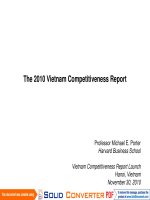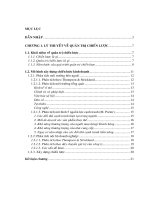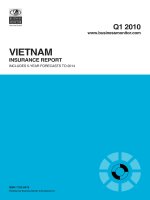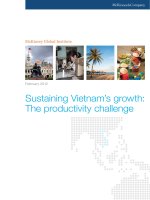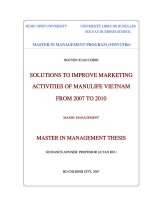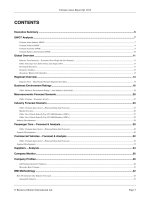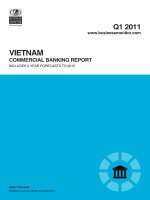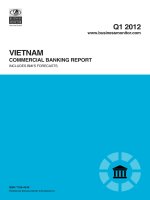vietnam insurance report q1 2010
Bạn đang xem bản rút gọn của tài liệu. Xem và tải ngay bản đầy đủ của tài liệu tại đây (831.04 KB, 93 trang )
Q1 2010
www.businessmonitor.com
INSURANCE REPORT
ISSN 1752-8410
Published by Business Monitor International Ltd.
VIETNAM
INCLUDES 5-YEAR FORECASTS TO 2014
Business Monitor International
Mermaid House,
2 Puddle Dock,
London, EC4V 3DS,
UK
Tel: +44 (0) 20 7248 0468
Fax: +44 (0) 20 7248 0467
Email:
Web:
© 2009 Business Monitor International.
All rights reserved.
All information contained in this publication is
copyrighted in the name of Business Monitor
International, and as such no part of this publication
may be reproduced, repackaged, redistributed, resold in
whole or in any part, or used in any form or by any
means graphic, electronic or mechanical, including
photocopying, recording, taping, or by information
storage or retrieval, or by any other means, without the
express written consent of the publisher.
DISCLAIMER
All information contained in this publication has been researched and compiled from sources believed to be accurate and reliable at the time of
publishing. However, in view of the natural scope for human and/or mechanical error, either at source or during production, Business Monitor
International accepts no liability whatsoever for any loss or damage resulting from errors, inaccuracies or omissions affecting any part of the
publication. All information is provided without warranty, and Business Monitor International makes no representation of warranty of any kind as
to the accuracy or completeness of any information hereto contained.
Vietnam Insurance
Report Q1 2010
Including 5-year industry forecasts by BMI
Part of BMI’s Industry Report & Forecasts Series
Published by: Business Monitor International
Publication date: December 2009
Vietnam Insurance Report Q1 2010
© Business Monitor International Ltd Page 2
Vietnam Insurance Report Q1 2010
© Business Monitor International Ltd Page 3
CONTENTS
Executive Summary 5
Table: Overview Of Vietnam’s Insurance Sector 5
Key Insights On Vietnam’s Insurance Sector 5
SWOT Analysis 7
Vietnam Insurance Industry SWOT 7
Vietnam Political SWOT 7
Vietnam Economic SWOT 8
Vietnam Business Environment SWOT 8
Global Outlook 9
Asia Pacific Overview 11
Projections And Forecasts 15
Table: Insurance Premiums, 2006-2014 15
Projections And Drivers Of Growth 15
Table: Growth Drivers, 2006-2014 16
Country Update 17
Macroeconomic Forecast 17
Table: Vietnam – Economic Activity, 2007-2014 19
Political Outlook 19
Insurance Business Environment Rating 22
Table: Vietnam’s Insurance Business Environment Indicators 22
Table: Asia Pacific Insurance Business Environment Ratings 23
Regional Context 24
Table: Non-Life Premiums In A Regional Context, 2008 24
Table: Life Premiums In A Regional Context, 2008 25
Major Players In Vietnam’s Insurance Sector 26
Table: Non-Life Segment By Lines, H109 (VNDmn) 26
Table: Life Segment By Lines, H109 (VNDmn) 27
Table: Leading Non-Life Companies By Gross Written Premiums, H109 (VNDmn) 27
Table: Leading Life Companies By Gross Written Premiums, H109 (VNDmn) 27
Analysis Of Regional Competitive Conditions 28
Local Company Profiles 33
Bao Minh 33
Bao Viet 34
PJICO 35
Regional Company Profiles 36
AEGON 36
AIG 37
Allianz 42
Aviva 45
Vietnam Insurance Report Q1 2010
© Business Monitor International Ltd Page 4
AXA 47
Cardif 49
Fortis 52
Generali 54
Groupama 56
HDI-Gerling 58
HSBC Insurance 61
ING Group 64
Liberty Mutual 65
Manulife 67
MetLife 69
Prudential Financial 72
Prudential Plc 75
QBE 78
RSA 80
Sun Life Financial 81
The Principal 83
Zurich Financial Services 84
Country Snapshot: Vietnam Demographic Data 86
Section 1: Population 86
Table: Demographic Indicators, 2005-2030 86
Table: Rural/Urban Breakdown, 2005-2030 87
Section 2: Education And Healthcare 87
Table: Education, 2002-2005 87
Table: Vital Statistics, 2005-2030 87
Section 3: Labour Market And Spending Power 88
Table: Employment Indicators, 1999-2004 88
Table: Consumer Expenditure, 2000-2012 (US$) 88
Methodology 89
Insurance Business Environment Ratings 90
Table: Insurance Business Environment Indicators And Rationale 90
Table: Weighting Of Indicators 91
Vietnam Insurance Report Q1 2010
© Business Monitor International Ltd Page 5
Executive Summary
Table: Overview Of Vietnam’s Insurance Sector
Non-life segment VNDmn US$mn EURmn
2008 premiums, mn 10,855,000 661 449
2008-2013 premium growth, mn 12,641,000 763 690
2008-2013 CAGR, % 17% 17% 20%
2008 penetration, % of GDP 0.7%
Segment Measure of Openness to New Entrants (out of 10) 5.0
BMI Segment Rating 32.5
Life segment
2008 premiums, mn 10,330,000 629 428
2008-2013 premium growth, mn 11,106,800 671 612
2008-2013 CAGR, % 16% 16% 19%
2008 penetration, % of GDP 0.7%
Segment Measure of Openness to New Entrants (out of 10) 5.0
BMI Segment Rating 35.0
Total insurance sector
2008 premiums, mn 21,185,000 1,289 877
2008-2013 CAGR, % 16% 16% 20%
2008 penetration, % of GDP 1.4%
BMI insurance business environment rating 44.2
CAGR = compound annual growth rate. Source: BMI
Key Insights On Vietnam’s Insurance Sector
This report differs from its predecessors in several respects. In our analysis of competitive conditions, we
provide a much more comprehensive ranking of insurance companies in the major segments from the
point of view of the organisation that is providing the data (in practice almost always the national
insurance regulator or the national insurance trade association). In Poland, for instance, the three largest
non-life companies in the first half of 2009 – in terms of Gross Written Premiums written - were PZU
SA, STU ERGO Hestia SA and TUiR WARTA SA, whose market shares were 38.9%, 10.0% and 9.4%
respectively. In the life segment, the leaders in the first half of 2009 were PZU Życie SA, ING TUnŻ SA
and TUnŻ WARTA SA, whose market shares were 28.1%, 11.1% and 9.4% respectively. Over time, we
hope to derive insights from observing how market shares change. We emphasise though, that a decline in
Vietnam Insurance Report Q1 2010
© Business Monitor International Ltd Page 6
share of Gross Written Premiums is not automatically a bad thing and is often the result of a deliberate
corporate decision to focus on more profitable business lines.
In this report, we also provide a breakdown of the insurance sector by line – from the point of view of the
regulator or the trade association. In Poland, for instance, the largest non-life lines in 2008 were
compulsory motor third party liability (CMTPL), land vehicles voluntary insurance (CASCO) and fire
and diverse risks. These accounted for 35%, 26% and 10%, respectively, of total non-life premiums. Over
time, we should be able to use this information to bring greater sophistication to our forecasting process.
Writing in December 2009, we have been able to ensure that the report includes actual data for 2008. We
have generally been able to use data that has been published over the course of 2009 to adjust our
forecasts for the year as a whole. We have also extended the forecasts out to 2014. We are looking for
total premiums in 2009 of VND21,743,254mn. This includes non-life premiums of VND11,757,081mn
and life premiums of VND9,986,174mn. In 2014, the corresponding figures should be
VND54,079,998mn, VND26,575,793mn and VND27,504,205mn. In terms of the key drivers that
underpin our forecasts, we are looking for non-life penetration to rise from .77% in 2009 to 1.08% in
2014, and for life density to rise from US$6 to US$9. BMI’s proprietary Insurance Business Environment
Rating for Vietnam is 44.2.
This quarter, we include a discussion of developments within regional markets on the basis of results
published by major cross-border companies in relation to Q209 or Q309 and the latest information
provided by regulators and/or trade associations. Aside from Singapore, most of the markets of South
East Asia represent small portions of the regional businesses of cross-border insurers in Asia Pacific. The
individual markets of South East Asia, other than Singapore, typically represent a small portion of the
regional business of the various multinational insurers who are active across the region. Nevertheless, it is
significant that many of the larger cross-border groups commented favourably on the performance of their
operations in Malaysia, the Philippines, Thailand, Vietnam and Indonesia through the first six to first nine
months of 2009. Improving perceptions of risk on the part of domestic investors have boosted demand for
long-term savings products. In many cases, it is the large multinationals that have benefited, at the
expense of smaller local groups. Thanks to reasonably resilient domestic demand, non-life insurance has
continued to develop, in some cases from low bases.
Vietnam Insurance Report Q1 2010
© Business Monitor International Ltd Page 7
SWOT Analysis
Vietnam Insurance Industry SWOT
Strengths
Both Vietnam’s life and non-life segments are rapidly growing.
Authorities are increasingly disposed to the benefits of foreign competition.
The economic conditions are – and are likely to remain – favourable, with a low
prospect of risks to the realisation of potential returns.
Weaknesses
The high growth anticipated in both the life and non-life segments of the Vietnamese
market is nonetheless coming off a very small base. Even if our optimistic projections
for 2008-2013 turn out to be correct, both segments will still be, relatively speaking,
underdeveloped in 2013.
Small number of players; particularly in the life segment.
GDP per capita is tiny, limiting the market for insurance products.
Opportunities
The ceding by large local firms of market share to rivals in the non-life segment
demonstrates the openness of the market to new players.
There are still large numbers of people who are underinsured (or uninsured).
Threats
Increasing prospect of high ongoing inflation represents a general economic threat.
Lack of development, volatility in Vietnamese capital and bond markets are a threat.
Vietnam Political SWOT
Strengths
Communist Party government appears committed to market-oriented reforms,
although specific economic policies will undoubtedly be discussed at the 2011
National Congress. One-party system generally conducive to short-term stability.
Relations with US generally improving; US sees Hanoi as a potential regional ally.
Weaknesses
Corruption among government officials a major threat to Communist Party legitimacy.
Increasing (albeit limited) public dissatisfaction with leadership's control over dissent.
Opportunities
The government recognises the threat that corruption poses to its legitimacy, and has
acted to clamp down on graft among party officials.
Has allowed legislators to become more vocal in criticising government policies. This
is opening up opportunities for more checks and balances within the system.
Threats
The slowdown in growth in 2009 and 2010 is likely to weigh on public acceptance of
the one-party system, and street demonstrations to protest economic conditions could
develop into a full-on challenge of undemocractic rule.
Although strong domestic control will ensure little change to Vietnam's political scene
in the next few years, over the longer term, the one-party-state will probably be
unsustainable.
Relations with China have deteriorated over the past year due to Beijing's more
assertive stance over disputed islands in the South China Sea and domestic criticism
of a large Chinese investment into a bauxite mining project in the central highlands,
which could potentially cause large-scale environmental damage.
Vietnam Insurance Report Q1 2010
© Business Monitor International Ltd Page 8
Vietnam Economic SWOT
Strengths
Vietnam has been one of the fastest-growing economies in Asia in recent years, with
GDP growth averaging 7.6% annually between 2000 and 2007.
The economic boom has lifted many Vietnamese out of poverty, with the official
poverty rate in the country falling from 58% in 1993 to 20% in 2004.
Weaknesses
Vietnam still suffers from substantial trade, current account and fiscal deficits, leaving
the economy vulnerable as the global economy continues to suffer in 2010. The fiscal
picture is clouded by considerable 'off-the-books' spending.
The heavily-managed and weak dong currency reduces incentives to improve quality
of exports, and also serves to keep import costs high, thus contributing to inflationary
pressures.
Opportunities
WTO membership has given Vietnam access to both foreign markets and capital,
while making Vietnamese enterprises stronger through increased competition.
The government will in spite of the current macroeconomic woes, continue to move
forward with market reforms, including privatisation of state-owned enterprises, and
liberalising the banking sector.
Urbanisation will continue to be a long-term growth driver. The UN forecasts the urban
population to rise from 29% of the population to more than 50% by the early 2040s.
Threats
Inflation and deficit concerns have caused some investors to re-assess their hitherto
upbeat view of Vietnam. If the government focuses too much on stimulating growth
and fails to root out inflationary pressure, it risks prolonging macroeconomic instability,
which could lead to a potential crisis.
Prolonged macroeconomic instability could prompt the authorities to put reforms on
hold, as they struggle to stabilise the economy.
Vietnam Business Environment SWOT
Strengths
Large, skilled, low-cost workforce has made Vietnam attractive to foreign investors.
Vietnam's location (proximity to China and other South East Asian states and its good
sea links) makes it good base for foreign firms to export to rest of Asia, and beyond.
Weaknesses
Vietnam's infrastructure is still weak. Roads, railways and ports are inadequate to
cope with the country's economic growth and links with the outside world.
One of the world's most corrupt countries. Its score in Transparency International's
2008 Corruption Perceptions Index was 2.7,in 20th place in the Asia Pacific region.
Opportunities
Vietnam is increasingly attracting investment from key Asian economies, such as
Japan, South Korea and Taiwan. This offers the possibility of the transfer of high-tech
skills and know-how.
Vietnam is pressing ahead with rivatisation of state-owned enterprises and
liberalisation of banking sector. This should offer foreign investors new entry points.
Threats
Ongoing trade disputes with the US, and the general threat of American
protectionism, which will remain a concern.
Labour unrest remains a lingering threat. A failure by the authorities to boost skills
levels could leave Vietnam a second-rate economy for an indefinite period.
Vietnam Insurance Report Q1 2010
© Business Monitor International Ltd Page 9
Global Outlook
There is little doubt now that the global recession is over, and that the prospects for 2010 are improving.
Our global growth forecast for 2009 has been revised up to -2.0% (from -2.1% in September); while for
2010 we project 2.5% global expansion (from 2.3%). One of the distinctive characteristics of this
recovery is the degree to which it is being driven by emerging – rather than developed – markets. Our
core view for most developed states continues to include deflationary pressures, deleveraging and
sluggish growth going into 2010. But in emerging states, output is rebounding quickly and inflationary
pressures are more acute. This is reflected in our aggregate estimates for developed market versus
emerging market real GDP growth in 2010, at 1.3% versus 4.4%.
The most substantial revision to our global assumptions stems from a significant shift in outlook from our
oil and gas team, which now envisages much higher oil prices in coming years. Our 2010 forecasts have
been raised to US$83.00 per barrel (bbl) for the OPEC basket (from US$60.00/bbl) and US$86.00/bbl for
Brent Crude (from US$61.00/bbl), while our long-term forecasts have increased to the low US$90s/bbl
from the low US$70s/bbl. According to our oil and gas team, these new assumptions are based on a
significant and sustained improvement in 2010 oil demand as economic activity picks up.
Developed States
We forecast developed state aggregate growth of 1.3% in 2010, up slightly from 1.2%. Notably, our
forecasts for the eurozone and Canada have been revised modestly upward. Our projections for Germany
and France have proved slightly pessimistic given the run of increasingly positive economic data, and this
has led to an upgrade of the eurozone real GDP growth aggregate to -3.9% from -4.3% previously for
2009, and to 0.5% from 0.4% for 2010. Meanwhile, Canada’s resilience through the global downturn, and
the prospects for higher commodity prices, led us to upgrade our 2010 forecast to 2.4%, from 1.6%. Our
current US forecast remains unchanged, at -2.7% in 2009 and 1.9% in 2010. However, both could be
revised depending on incoming data for Q309.
Emerging Markets
Emerging market growth is forecast at 4.4% in 2010, up from 4.3% and a significant rebound from the
0.7% we forecast for 2009. We expect to see greater inflationary pressures in the emerging market
universe compared with developed states, which will lead to more aggressive tightening among emerging
market monetary authorities. While our core view is that growth is set to persist in most emerging
markets beyond 2010, tightening policy puts a ‘double-dip’ scenario back into play.
Emerging Asia is forecast to grow by 6.7% in 2010, an upgrade from 6.5% previously and ahead of the
6.6% growth in 2008. Base effects, particularly in exports and inventories, will be key to this growth. Our
near-term forecasts are also driven by our China outlook, as we see the country’s economy expanding by
Vietnam Insurance Report Q1 2010
© Business Monitor International Ltd Page 10
8.8% in 2010 and 8.4% in 2011 on the back of considerable government stimulus. The biggest regional
risk stems from China, as we are concerned about a potential double-dip recession over the medium-term.
We see Latin America and emerging Europe growing by 2.0% and 2.3%, respectively, in 2010. While our
Latin America forecast has remained relatively flat in recent months, our emerging Europe outlook has
improved from 1.9% a few months ago, owing to upgrades for regional heavyweights Turkey and Poland.
Both regions will be negatively affected by sub-par performances by the regional developed economic
juggernauts: the US (for Latin America) and the eurozone (for emerging Europe).
Sub-Saharan Africa is the biggest mover in our 2010 forecasts, rising from 3.8% to 4.9%, owing mainly
to our much more optimistic appraisal of the Nigerian economy. Our Middle East and North Africa
forecast remains relatively flat at 3.5% (3.4% previously), but granted, we had not been nearly as
pessimistic on 2010 prospects in the Middle East and North Africa to begin with as we had for other
regions.
Vietnam Insurance Report Q1 2010
© Business Monitor International Ltd Page 11
Asia Pacific Overview
First Nine Months Of 2009 – No Bonanza, But Not Bad Either…
By early December 2009 enough information had been made available by the major cross-border
insurance companies that have a presence across Asia Pacific to gain a clear picture of general trends in
non-life and life insurance markets in the various countries. Overall, figures pointed to several of the
largest players ceding market share and/or by some measures actually losing ground in terms of absolute
premiums written. Nevertheless, insurers’ earnings generally held up. This was partly because of lower
expenses and claims, partly because of a sharp recovery in investment earnings thanks to the gains made
by regional stock markets and, in some instances, because of decisions by corporate managements to
focus on particular business lines.
In global terms, Asia Pacific remains hugely prospective for both non-life and life insurers. Structurally,
high savings rates, growing populations and under-developed financial services sectors indicate that life
insurance should continue to grow – even in countries where penetration and density are already at fairly
elevated levels. In poorer countries (or, more correctly, poorer parts of countries) demand for non-life
insurance is rising sharply as a result of growing incomes.
A Glance At Allianz
Allianz, for instance, noted that its non-life premiums written across Asia Pacific rose (after allowing for
currency movements) from EUR324mn in the first three quarters of 2008 to EUR353mn in the first three
quarters of 2009. The corresponding figures for Australia, which are counted separately, were
EUR1,158mn and EUR1,290mn. Globally, Allianz’s non-life premiums fell from EUR33,959mn to
EUR33,500mn.
Meanwhile, Allianz’s life premiums in the region increased by 16.3% year-on-year (y-o-y) after allowing
for currency movements to EUR985mn in Q309. “This development was mainly driven by an increase of
81.3% or EUR157mn in Taiwan, where consumer confidence returned in line with the stock market
recovery. For the nine months to the end of September 2009, Allianz’s gross life premiums across the
region were EUR2,649mn, or slightly less than the EUR2,821mn in the same period a year earlier. Life
premiums increased in Taiwan (as noted above), Malaysia (from EUR101mn to EUR127mn), and
Indonesia (from EUR134mn to EUR152mn). However, they fell in South Korea (from EUR1,253mn to
EUR1,165mn) and other countries in the region (presumably Allianz’s joint ventures in China and India.)
China’s Life Segment Consolidates
One of the less well-documented aspects of 2009 is that it was a year of consolidation for China’s life
segment. In local currency terms, life premiums rose by 13% y-o-y in 2006, 8% in 2007 and 49% in 2008.
Figures released by the China Insurance Regulatory Commission (CIRC) indicated that, in the first 10
months of 2009, ‘other’ life insurance premiums (meaning premiums that are not for personal accident or
Vietnam Insurance Report Q1 2010
© Business Monitor International Ltd Page 12
health cover) increased by 6.7% y-o-y, to CNY625,027.1mn. China Life’s report to the Hong Kong
Stock Exchange in relation to the period ending September 30 2009 noted that that company’s gross
written premiums fell from CNY247,139mn in the first nine months of 2008 to CNY235,434mn in the
first nine months of 2009. Although the company did not discuss this in its report, it appears that China
Life is taking a selective approach to the risks that it is underwriting, rather than pursuing growth for its
own sake.
Ping An, in contrast, has been increasing its share of both the life and the (much more rapidly growing)
non-life market. As that company notes in its report for Q309, ‘For our life insurance business, the
premium income and the number of sales agents exhibited obvious increase [sic]. Gross written
premiums, policy fees and premium deposits for the past three quarters reached CNY104,724mn,
representing an increase of 33.5% as compared with the corresponding period of last year.’
Ping An noted that its share of the Chinese life market was just under 17% and that the number of agents
had risen by 13% to 403,000 since the beginning of 2009. Ping An spoke for just over 12% of the Chinese
non-life market. Non-life premiums in the first three quarters of 2009 were CNY29,020mn, up 38.5% y-
o-y.
CIRC’s latest figures confirm that non-life insurance continues to boom in China. Property insurance
premiums grew by 21.5% from CNY200,119.7mn in the first 10 months of 2008 to CNY243,179.6mn in
the first 10 months of 2009. Personal accident premiums rose by 13.3% to CNY20,222.1mn. However,
health premiums actually fell by 7.6% to CNY47,665mn.
AIG, AXA And Manulife
In part because of more difficult conditions in some of the areas in which it operates, AIG reported that
total revenues from non-US general insurance premiums slipped from US$10,991mn in the first nine
months of 2008 to US$9,898mn in the first nine months of 2009. ‘The consumer lines business was
affected by the continued global recessionary pressure reducing the number of overseas travellers and
auto sales, especially in the Far East region.’
AIG also noted that premiums and other considerations from its Asian life/retirement businesses (Nan
Shan in Taiwan, Philamlife in the Philippines and AIA in other countries) in the first nine months of
2009 amounted to US$10,489mn, or down about 8% lower y-o-y.
For its part, French giant AXA achieved good growth in H109 non-life premiums in most of the markets
that it operated in across Asia Pacific. Gross revenues in Singapore, for instance, rose by 28% to
EUR15mn, thanks to higher rates. AXA’s motor insurance business also fared well in Hong Kong (where
the health insurance business expanded), Malaysia and Japan. Across the region, AXA’s life business was
Vietnam Insurance Report Q1 2010
© Business Monitor International Ltd Page 13
hampered by slippage in sales of unit-linked life products which in turn was the result of investors
responding to the volatility in global stock markets.
The general tenor of comments from Manulife, a Canadian major that is present in many Asia Pacific
markets, was considerably more upbeat. ‘In Asia, record insurance sales levels were achieved in the
[September 2009] quarter, with overall sales exceeding the prior year by 16% on a constant currency
basis. Japan sales were up 7% over the prior year, while Hong Kong sales increased by 29%, with strong
sales momentum bolstered by new product offerings and distribution initiatives. Japan and Indonesia
reported significant market share gains in 2009 reflecting consumer flight to quality. China sales also
continued to grow, up 18% in the quarter, reflecting contributions from new offices opened in the prior
year and recent marketing initiatives. During the quarter Manulife continued to expand its operations in
China, receiving an additional licence in the province of Tianjin. This brought the total number of
licences to 38, among the most of any foreign life insurer in China.’
Prudential – Focusing On Margins
Of the international life insurers that have a substantial presence across Asia Pacific, Prudential perhaps
provided the most comprehensive review of developments in the various markets. In general, Prudential’s
premiums have fallen by double-digit amounts, while earnings have held up as a result of ‘higher margins
driven by higher proportions of regular premiums and protection products’. Prudential’s new business
sales fell, in annual premium equivalent (APE) terms from GBP648mn in H108 to GBP553mn in H109.
New business profits (NBP) dropped by just 4% to GBP277mn. Total European embedded value (EEV)
operating profit dropped from GBP460mn to GBP401mn. However, international financial reporting
standards (IFRS) operating profit increased from GBP72mn to GBP212mn. Highlights of the H109 that
were identified in Prudential’s review included:
Success across the region of ‘protection’ products (which account for almost one-third of Prudential’s
premiums across the region). These products ‘have … proven to be useful in maintaining agency
momentum as they address one important customer need and typically have lower premiums, making
them more affordable when household budgets are stretched.’
A number of holders of unit-linked products in South Korea, and to a lesser extent Hong Kong and
Singapore, opting to suspend premium payments (take a premium holiday) in response to the global
financial crisis. Competitive pressures picked up in South Korea, thanks to the promotion by rivals of
‘hot products’ in an ‘increasingly open architecture environment’.
A shift towards bank distribution in China, where the APE new business of CITIC-Prudential Life
rose 11% to GBP21mn. ‘The agency channel has been particularly affected by the economic climate
and, in general, recruiting and retaining good quality agents remains a challenge.’
Vietnam Insurance Report Q1 2010
© Business Monitor International Ltd Page 14
A move towards sales through agents in Hong Kong, where ‘sentiment towards single-premium
business via the bank channel … remains negative due to the lingering impact of the Lehman
Brothers mini-bond issue.’
A sharp fall in new business APE in India, ‘reflecting a particularly challenging market and our stated
policy of concentrating on value over volume.’
The transfer of Prudential’s agency force and the related back-book, in Taiwan, to China Life.
Prudential continues to distribute its products in Taiwan through partnerships with Standard
Chartered Bank and E. Sun Bank.
The sharp downturn in new business in Singapore, where results for H108 had been boosted by
‘exceptional volumes of Central Provident Fund’ business ahead of a regulatory change.
Strong growth elsewhere in South East Asia. [should the previous sentence be the start of a bullet point?]
New business APE premiums were up 33% y-o-y in Malaysia in H109. New business APE in Indonesia
was down just 6%, ‘in spite of challenging conditions’, particularly in the first three months of 2009.
‘Vietnam has seen a good turnaround in agency activity and, combined with the smaller operations in
Thailand and the Philippines, APE is down only 7% on the first half of 2009.’
Vietnam Insurance Report Q1 2010
© Business Monitor International Ltd Page 15
Projections And Forecasts
Table: Insurance Premiums, 2006-2014
VNDbn 2006 2007 2008 2009f 2010f 2011f 2012f 2013f 2014f
CAGR
2008-
2013, %
Non-life 7,000 8,350 10,855 11,757 14,959 17,442 20,575 23,496 26,576 17%
% change
y-o-y 19% 19% 30% 8% 27% 17% 18% 14% 13%
Life 8,450 9,500 10,330 9,986 13,035 15,123 16,661 21,437 27,504 16%
% change
y-o-y -7% 12% 9% -3% 31% 16% 10% 29% 28%
Total 15,450 17,850 21,185 21,743 27,994 32,564 37,236 44,933 54,080 16%
% change
y-o-y
3% 16% 19% 3% 29% 16% 14% 21% 20%
US$mn
Non-life 438 519 661 657 787 943 1,176 1,424 1,715 17%
% change
y-o-y
18% 19% 27% -1% 20% 20% 25% 21% 20%
Life 529 591 629 558 686 817 952 1,299 1,774 16%
% change
y-o-y
-8% 12% 6% -11% 23% 19% 16% 36% 37%
Total 966 1,110 1,289 1,215 1,473 1,760 2,128 2,723 3,489 16%
% change
y-o-y
2% 15% 16% -6% 21% 19% 21% 28% 28%
EURmn
Non-life 350 379 449 466 575 707 929 1,139 1,372 20%
% change
y-o-y
18% 8% 18% 4% 23% 23% 31% 23% 20%
Life 423 431 428 396 501 613 752 1,039 1,420 19%
% change
y-o-y
-8% 2% -1% -7% 26% 22% 23% 38% 37%
Total 773 811 877 862 1,076 1,320 1,681 2,179 2,791 20%
% change
y-o-y 2% 5% 8% -2% 25% 23% 27% 30% 28%
f = forecast. Source: Regulator(s) and/or trade association(s), BMI
Projections And Drivers Of Growth
In the past, we assumed that non-life insurance premiums were driven by two factors: nominal GDP and
penetration. Furthermore, we assumed that non-life penetration (i.e. premiums as a percentage of GDP)
Vietnam Insurance Report Q1 2010
© Business Monitor International Ltd Page 16
would rise steadily from the 2008 level to the level we projected for 2013. In a similar way, we assumed
that life premiums were driven by two factors: total population and density (i.e. premiums per capita). We
assumed that life density would rise steadily from the 2008 level to the level that we projected for 2013.
In this report we seek to improve our forecasting technique. We will, if possible, project premiums ‘from
the bottom up’. Specifically, we seek to incorporate hard numbers published by the regulator and/or trade
association in relation to the development of the insurance sector. We will also try to incorporate the data
that is available in relation to particular lines. If, for instance, compulsory third-party motor liability
(CTPML) insurance dominates the non-life segment (as it does in some countries), then growth in non-
life premiums will depend on factors such as the numbers of motor vehicles and pricing.
Table: Growth Drivers, 2006-2014
Non-life 2006 2007 2008 2009f 2010f 2011f 2012f 2013f 2014f
Nominal GDP, US$bn 60.9 71.1 89.8 85.7 96.1 108.1 127.1 142.4 158.6
Penetration, % of GDP 0.72 0.73 0.74 0.77 0.82 0.87 0.93 1.00 1.08
Density, US$ per
capita 5.19 6.07 7.61 7.46 8.83 10.43 12.84 15.34 18.22
– EUR per capita 4.15 4.43 5.18 5.30 6.44 7.82 10.14 12.28 14.58
Life
Population, mn 84.4 85.6 86.8 88.0 89.2 90.4 91.6 92.8 94.1
Life penetration, % of
GDP
0.87 0.83 0.70 0.65 0.71 0.76 0.75 0.91 1.12
Life density, US$ per
capita 6.26 6.90 7.24 6.34 7.69 9.04 10.39 14.00 18.86
Life density, EUR per
capita 5.01 5.04 4.93 4.50 5.61 6.78 8.21 11.20 15.09
Exchange rates
US$/EUR 0.80 0.73 0.68 0.71 0.73 0.75 0.79 0.80 0.80
VND/US$ 15,987 16,076 16,431 17,900 19,000 18,500 17,500 16,500 15,500
f = forecast. Source: IMF, BMI
Vietnam Insurance Report Q1 2010
© Business Monitor International Ltd Page 17
Country Update
Macroeconomic Forecast
Double Dip Now Our Core Scenario
With Vietnam's balance of payments yet again approaching breaking point, we expect a sharp tightening
of fiscal and monetary policy in 2010, which will see real GDP growth dip to 4.4% from an expected
5.1% in 2009. This will raise criticism of economic policy at the 11th National Congress in January 2011,
but we expect the market reform agenda to be maintained.
We have shifted our Vietnam growth outlook from expecting a gradual economic recovery in 2010 to a
double-dip scenario with real GDP expansion dipping from an expected 5.1% in 2009 to 4.4% in 2010.
This is based on our expectations that fiscal and monetary policy will have to be tightened sharply in
early 2010 in order to rein in the widening trade deficit and halt inflationary pressures. Our outlook for
Vietnam has much in common with that for China. However, while the policy aims of the respective
governments are similar, we view the macroeconomic concerns in Vietnam as more alarming, at least in
the short term, as Hanoi's fiscal and monetary resources are considerably more limited.
As a consequence, we find it likely that the inevitable shift towards tighter monetary and fiscal policy will
come earlier in Vietnam than in China. Indeed, while Hanoi's fiscal and monetary stimulus has helped
economic growth recover from a low of 3.1% y-o-y in Q109 to 5.2% in Q309, it has also been a key
factor, in our view, behind a considerable widening of the trade deficit over the same period to US$1.9bn
in October. While the return to positive growth in G3 markets in H209 and 2010 should give some
support to Vietnamese exports, we believe a continuation of the current accommodative policy would
lead to a further widening of the trade deficit.
With Vietnam's foreign exchange reserves in Q409 estimated to be below the three months of imports
seen as a minimum, we believe drastic policy action will be needed to avoid a balance-of-payments crisis.
This will include:
A downward adjustment of the dong towards our VND19,000/US$ end-2009 forecast, from
VND17,862/US$ on November 6, to stem the outflow of US dollars through the trade channel.
A hiking of policy rates to uphold public confidence in the dong, stem capital outflows, and contain
upward pressure on inflation through higher import prices. We are now expecting 500bps of hikes in
2010, bringing the Vietnam base rate from 7.00% in November 2009 to 12.00%.
Vietnam Insurance Report Q1 2010
© Business Monitor International Ltd Page 18
A reduction of the fiscal deficit from VND118trn (US$6.6bn), or 7.2% of GDP, to VND105trn
(US$5.9bn), or 5.7% of GDP, in 2010 on the back of reductions in both current and capital expenditure
growth.
Implications For Growth
We expect the fiscal and monetary tightening to lead to a double dip in growth after the tentative rebound
seen in the last three quarters of 2009. We are expecting real GDP growth to come in at 4.4% in 2010, as
weak growth in G3 markets will weigh on exports and prevent a marked improvement in net exports in
spite of the devaluation of the dong.
This will mean that the slowdown in domestic demand will be harder felt. With inflation expected to
average roughly 9.0% in 2010, we expect government consumption to decrease by 3.5% in real terms,
which will shave 0.3 percentage points (pp) off headline growth. A more marked effect will be coming
from a slowdown in private consumption growth as credit conditions are tightened. We expect private
consumption growth (in real terms) to slow to 2.3% from an expected 4.9% in 2009 and 9.2% in 2008.
This should see the contribution to growth from private consumption decrease to 1.6pp in 2010 from
3.3pp in 2009 and a massive 6.0pp in 2008.
We are, on the other hand, expecting an increase in the contribution from gross fixed capital formation
from 0.4pp to 1.1pp as FDI disbursements, down 12.1% y-o-y to US$8bn in January-October 2009,
recover and state-and [?] aid-financed projects gather pace. However, the precarious state of the property
market, where activity and prices have been supported by the loan-subsidy programme, is a risk to this
forecast. While only a minority of property purchases are financed through bank lending, higher interest
rates should still have an impact on the market and on commercial and residential construction.
Policy Rebalancing Needed At 2011 Party Congress
We expect the slowdown in growth in 2009 and 2010 to make economic policy the main matter of debate
during the Communist Party of Vietnam (CPV)'s 11th National Congress scheduled for January 2011.
The macroeconomic rollercoaster ride experienced in recent years has raised criticism against Prime
Minister Nguyen Tan Dung, the most important proponent of economic reform, from more conservative
members in the Politburo. We believe the mainstay of the CPV is still behind Nguyen's reform agenda,
meaning that there will be no drastic shift in the socio-economic development strategy for 2011-2016.
However, we expect measures to be taken to achieve greater macroeconomic stability, including a
reduction of official growth targets, a shift in monetary policy towards inflation targeting and increased
exchange rate flexibility. This is likely to come at a cost to economic growth in the short term, and we are
consequently forecasting real GDP growth of 5.5% and 6.0% in 2011 and 2012, respectively, as the
global economic environment is expected to be less conducive than in the 2003-2007 boom years. A
failure to take a decision on rebalancing economic policy would, on the other hand, mean a high risk of a
Vietnam Insurance Report Q1 2010
© Business Monitor International Ltd Page 19
continuation of macroeconomic volatility as expressed in Vietnam's score of 43.8 out of 100 in our short-
term economic risk ratings.
Table: Vietnam – Economic Activity, 2007-2014
2007 2008e 2009f 2010f 2011f 2012f 2013f 2014f
Nominal GDP,
VNDbn
1
1,144,015 1,478,695 1,628,770 1,825,075 2,053,255 2,288,455 2,562,686 2,855,653
Nominal GDP, US$bn
1
71.1 89.8 85.7 96.1 108.1 123.7 138.5 154.4
Real GDP growth, %
change y-o-y
1
8.5 6.2 5.1 4.4 5.5 6.0 6.8 6.9
GDP per capita, US$
1
835 1,035 974 1,077 1,195 1,350 1,492 1,640
Population, mn
2
85.6 86.8 88.0 89.2 90.4 91.6 92.8 94.1
Industrial production
index, average %
change y-o-y
3
16.7 14.9 6.8 10.0 12.0 14.0 14.0 14.0
Unemployment, % of
labour force, end of
period
3
4.6 5.0 5.5 5.5 5.0 4.5 4.0 4.0
NB Figures in this table may differ from those quoted elsewhere in the report; e/f = BMI estimate/forecast. Sources:
1
IMF
(General Statistics Office);
2
IMF;
3
General Statistics Office.
Political Outlook
Relations With China At Forefront Of Internal Power Struggle
Vietnam's relations with China have come to the forefront of an internal power struggle within the
Communist Party of Vietnam, pitting economic reformers centred around Prime Minister Nguyen Tan
Dung against more conservative Politburo members with links to China. With the two factions seeking to
strengthen their positions ahead of the 2011 National Congress, we believe the reformists will maintain
the upper hand.
Faced with ever-increasing internet penetration and an army of bloggers, the Communist Party of
Vietnam (CPV) has in recent years sought to improve its means of monitoring and controlling public
opinion. Nonetheless, hardliners within the Politburo are now arguing that increasingly unruly
expressions of dissent against public policy on the internet is evidence of Prime Minister Nguyen Tan
Dung's reformist agenda getting out of control, thus necessitating a policy redirection. Indeed, this is
becoming a key theme ahead of the CPV's next National Congress, scheduled for early 2011, which
threatens to pit economic reformers against more conservative hardliners in the quest for political
nominations.
Vietnam Insurance Report Q1 2010
© Business Monitor International Ltd Page 20
The rapid economic growth seen in recent years has undermined the base for political dissidents in
Vietnam as the general public has seen little reason to oust a regime that has delivered tangible material
gains for the majority of the population. Nonetheless, the CPV has become notably unnerved by an
increasing mass of political opinion driven by the easy access to internet and online forums that a
majority of the Vietnamese population now enjoys. Vietnamese authorities have estimated that 21mn
Vietnamese use the internet, and there are reportedly between 1mn and 4mn blogs, covering a wide area
of topics. To police this immense body of content, the government regulates internet content and usage
through a variety of technical and legal means, but users are constantly seeking and finding means to
circumvent these measures, in spite of the heavy penalties handed down by the authorities.
China Dominating Internet Discussion
The most inflammatory subject on Vietnamese blogs over the past year has been Hanoi's relationship with
China, which has been tested by ongoing disputes over the Paracel and Spratly islands in the South China
Sea, a controversial Chinese-financed bauxite mining project in the central highlands and a severely
skewed trade relationship. A number of journalists and bloggers have criticised both the Chinese and
Vietnamese government's conduct in these disputes, a criticism that has fallen on fertile ground as the
Vietnamese public is highly sensitive to any perceived encroachment of Vietnam's sovereignty by its
northern neighbour.
With the regime in Hanoi fearful of China's sensitivity to any criticism and aware of the need to maintain
a working relationship with Beijing, the authorities have stepped in to stem any perceived instigation of
anti-Chinese public opinion. This has seen the arrest of journalists and bloggers who have published
articles and blogposts critical of China, on the basis that the criticism threatens efforts by the two
governments to reform the economic relationship between the two countries. This has so far been
characterised by a heavily skewed trade flow with an avalanche of cheap Chinese goods flooding the
Vietnamese market, driving local competitors out of business, with little but commodities such as coal
and rubber going the other way. The massive trade deficit with China - which amounted to US$11.1bn in
2008, roughly 12% of GDP - has been a subject of dispute between Chinese and Vietnamese leaders in
recent years, and thus a point of discussion during Prime Minister Nguyen Tan Dung's visit to China in
April 2009.
The perceived solution to achieve a more mutually beneficial economic relationship has been to promote
increased Chinese investment in Vietnam. This does indeed make economic sense as investment from
Vietnam's traditional sources of foreign direct investment - Malaysia, Singapore, South Korea and
Taiwan - is likely to be less forthcoming over the next few years as foreign investment partners rebuild
their balance sheets and pare back their expansion plans. Indeed, foreign direct investment pledges have
dropped 85.7% y-o-y in the first three quarters of 2009 to US$7.6bn. The crux is that with a
manufacturing sector equally, if not more, competitive than Vietnam's, Chinese interest in investing in
Vietnam Insurance Report Q1 2010
© Business Monitor International Ltd Page 21
Vietnam has almost exclusively been directed towards the extractive industries, with the aim of securing
resources to fuel the Chinese industrial behemoth.
This has fuelled allegations in the case of the bauxite mining project in Lam Dong province that China is
merely exploiting Vietnam's natural resources, while causing considerable environmental damage in the
central highlands, which are both scenic and the centre of Vietnam's coffee industry. Added to this is the
tendency of Chinese investors to bring their own workers rather than employ locals, making the severe
public backlash against the investment plans unsurprising. With technical solutions failing adequately to
prevent the posting of inflammatory content on the internet, the government has turned to incarcerating a
number of bloggers and journalists to deter the voicing of critical opinion.
Political Jockeying Ahead Of 2011 Congress
The ability to control domestic dissent has become a key issue ahead of the CPV's 11th National
Congress, scheduled for early 2011, at which key appointments and policy decisions are to be made. The
increasing leeway of opinion expressed in new media has reportedly become a sticking point for more
conservative forces within the CPV to argue that Prime Minister Dung has gone too far in his policy of
economic liberalisation and increased openness towards the US and North East Asian countries such as
Japan and South Korea at the expense of Hanoi's relationship with its ideological brethren in Beijing. This
could lay the ground for a serious confrontation at, or before, the 11th National Congress.
We continue to expect Nguyen to maintain his authority within the Politburo as a younger, less
ideological generation of CPV members is strongly supportive of continued economic reform. However,
he is likely to face continued opposition from a more conservative faction within the Politburo, which
believes that his agenda of increased economic liberalisation is putting the CPV's monopoly on public
opinion - and, by extension, political power - at risk. Members of this faction are said to be at the
forefront of the reaction against bloggers, since the General Department II (GDII), an intelligence unit led
by Vice Defence Minister Nguyen Chi Vinh, has been instrumental in tracking and punishing political
dissent on the internet. It has been alleged that hardliners have also used the technology at the command
of GDII to monitor ideological opponents within the CPV, thus gaining an upper hand in the behind-the-
scenes jostling for promotions that characterises the CPV and other power structures. While there is thus a
risk that the internal power struggle could intensify ahead of the National Congress, we see no major risks
to policy direction. Hence, we maintain our 90 out of 100 rating for Vietnam in the policy continuity sub-
category of our short-term political risk ratings. With inflation currently in low single digits and the
conflict with China over the Paracel and Spratly islands contained, Vietnam scores a high 80 out of 100 in
our short-term political risk rating. A low characteristics of polity rating (27.6 out of 100) brings
Vietnam's long-term political risk rating down to 52.8, reflecting our view that one-party rule is
unsustainable in the longer term.
Vietnam Insurance Report Q1 2010
© Business Monitor International Ltd Page 22
Insurance Business Environment Rating
Table: Vietnam’s Insurance Business Environment Indicators
Limits of potential returns Data
Score, out
of 10 Rating score, out of 100
Non-life premiums, 2008 Us$660.6mn 2.0 Non-life 32.5
Non-life premium increase, 2008-2013 US$763.4mn 4.0
Non-life penetration, 2008 0.7% of GDP 2.0
Measure of openness 5.0
Life premiums, 2008 US$628.7mn 2.0 Life 35.0
Life premium increase, 2008-2013 US$670.5mn 4.0
Life penetration, 2008 0.7% of GDP 3.0
Measure of openness 5.0
GDP per capita, 2008 US$1,034.6 2.0 Country structure 44.0
Active population, % of total 65.9% 7.0
Tax 5.0
GDP volatility 5.0
Financial infrastructure 3.0
Risks to realisation of returns
Regulatory framework and development 6.0 Regulatory framework 55.0
Regulatory framework and competitive landscape 5.0
Long-term financial risk 8.0 Country risk 61.4
Long-term external risk 4.3
Long-term policy continuity 9.5
Legal framework 3.9
Bureaucracy 4.9
Insurance business environment rating 44.2
Source: BMI
Since last year we have been taking a much more systematic approach to assessing the current and
potential conditions of the insurance sectors in each of the countries surveyed by BMI. We have
calculated the Insurance Business Environment Rating (IBER), which takes into account objective
measures of the current state and long-term potential of both the non-life and the life segments. It also
takes into account an assessment of the openness of each segment to new entrants, and economic
conditions. Collectively, these measures enable an objective assessment of the limits to potential returns
across all countries and over a period of time. The IBER also incorporates an objective assessment of the
Vietnam Insurance Report Q1 2010
© Business Monitor International Ltd Page 23
risks to the realisation of returns. The risk assessment is based on BMI’s Country Risk Rating. It
embodies a subjective assessment of the impact of the regulatory regime on the development and the
competitive landscape of the insurance sector.
In early 2009, the overall IBER for Vietnam was 43.6. By this measure, the country is lower-middle
ranking in terms of its attractiveness relative to other countries in the Asia Pacific region that were
surveyed by BMI. As shown in the tables, the IBER has five components. The last of these – the Country
Risk Factor of the Risks to the Realisation of Return
s
– boosts Vietnam’s overall IBER. To some extent,
this compensates for the low scores in other areas of IBER. In general, Vietnam’s IBER is held back by
the small size of both the life and non-life segments. The low GDP per capita has also contributed to a
low Country Structure score in the Limits of Potential Returns
component of the IBER.
Table: Asia Pacific Insurance Business Environment Ratings
Limits of potential returns Risks to realisation of returns
Non-life
segment
Life segment
Country
structure
Regulatory
framework
Country risk Rating Rank
Hong Kong 55.0 80.0 77.1 100.0 80.9 76.5 1
Australia 77.5 77.5 72.5 90.0 68.8 76.0 2
South Korea 77.5 77.5 70.6 60.0 73.9 72.8 3
Singapore 62.5 57.5 72.6 95.0 83.8 72.0 4
Taiwan 57.5 80.0 65.1 70.0 74.0 68.8 5
Malaysia 52.5 62.5 63.6 75.0 69.9 63.5 6
China 62.5 72.5 54.4 55.0 70.0 62.8 7
Thailand 50.0 55.0 59.8 70.0 53.6 56.9 8
Indonesia 47.5 65.0 52.3 55.0 49.9 53.8 9
Philippines 40.0 55.0 50.0 75.0 58.6 53.5 10
India 55.0 65.0 42.6 45.0 60.2 53.4 11
Vietnam 32.5 35.0 44.0 55.0 61.4 44.2 12
Pakistan 27.5 22.5 43.1 40.0 53.7 37.0 13
Sri Lanka 25.0 22.5 44.1 45.0 48.7 36.5 14
Bangladesh 22.5 20.0 46.9 20.0 44.2 32.4 15
Scores out of 100, with 100 the best. Source: BMI
Vietnam Insurance Report Q1 2010
© Business Monitor International Ltd Page 24
Regional Context
Table: Non-Life Premiums In A Regional Context, 2008
Premiums, US$mn Premiums, EURmn
Penetration,
% of GDP
Density,
US$ per capita
Density,
EUR per capita
Australia 24,036 16,344 2.67 1,144.55 778.30
Bangladesh 154 105 0.19 1.08 0.74
China 44,974 30,583 1.04 33.39 22.71
Hong Kong 3,468 2,359 1.61 495.49 336.93
India 7,051 4,795 0.53 6.11 4.15
Indonesia 2,653 1,804 0.54 11.31 7.69
Malaysia 3,044 2,070 1.47 112.75 76.67
Pakistan 542 369 0.33 3.37 2.29
Philippines 948 645 0.59 10.57 7.19
Singapore 4,843 3,293 2.78 1,009.01 686.13
South Korea 33,885 23,042 4.51 697.23 474.12
Sri Lanka 338 230 0.83 17.41 11.84
Taiwan 9,366 6,369 2.47 407.23 276.92
Thailand 3,110 2,115 1.17 48.37 32.89
Vietnam 661 449 0.74 7.61 5.18
Source: BMI estimates
